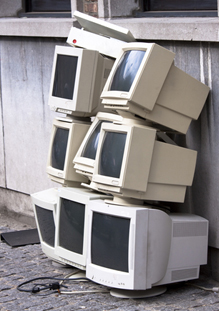Electronics Recycling, Like Battery Recycling, Declares Victory Too Soon
On March 18, electronics recycling was front page news in the New York Times. Or should I say that the remains of a potential future superfund site was the basis of the article.
As noted, the problem with putting the cart before the horse was outlined within the article as it pertains to Cathode Ray Tubes. CRT’S are those old style monitors and TVs that use a Cathode Ray beamed on a screen to create an image. I outlined this because this 20th Century technology required leaded glass to protect against radiation.
When more Cathode Ray Tubes were being made, industry could reclaim the leaded glass and make more product. In other words, we had a market for the old tubes and recyclers could make money, towns and counties that had recycling programs could be paid for their electronic waste and all was right with the world.
In my recycling classes, we make a point of touring different recycling technologies and recycling facilities. For many years we have toured Newtech Recycling in Somerset, N.J. I recall early on in this course that the founder of that company pointed out that users should be very careful in selecting an electronics recycler as the disreputable companies would promise much, but were probably just dumping the less valuable components overseas.
The first ewaste fiasco was exactly as he said. People were shocked to see their ewaste being dismantled by young children in developing nations over open fires and being exposed to heavy metals and toxic fumes.
 Safeguards were put in place and this practice was severely reduced.
Safeguards were put in place and this practice was severely reduced.
Now we find that the problem has come to back to haunt us again. Except this time, we are finding that the ewaste is being dumped right here at home as well as overseas.
CRTs are simply not being made much, if at all, any more. Now the screen world is dominated by flat screens that use either fluorescent tubes or LEDs. As the article notes, this means that CRTs have no market that will pay for the leaded glass and flat screens have lowered quantities of valuable materials to reclaim.
The result? A market shift that could be used in any entry level economics course teaching about the laws of supply and demand. With no demand, and a more than ample supply of leaded glass value of this glass has crashed.
Unfortunately, at the same time as this trend (which we should have been able to predict) was taking place, we had three major events take place. The first was the shift to flat screens outlined earlier, the second was the switch to hi definition TV that resulted in so many CRTs becoming obsolete at the same time. Finally, many states, such as NJ passed mandatory ewaste recycling laws (as we should have years ago in my opinion).
The result, a change in the market place to new technology and a crash in value of old technology at the time that many new ewaste recyclers; or as I like to call them, opportunists, entered the game. These new players promised values that they could not deliver to local governments desperate for money.
A perfect storm. Indeed, recycling history is full of these examples in different forms. From paper recycling bubbles to glass and plastic price bubbles we have seen so many people chase the quick dollar. And always the result is the same. CRASH.
Unfortunately, this time the crash means that we are left with huge piles of toxic materials that need to be cleaned up.
Unlike the other materials that may be abandoned, when electronic waste is left behind it poses large issues of contamination that will lead to law suits and potential superfund sites.
There is some good news here. As these materials are toxic, it is possible that the doctrine of strict and severe liability will be triggered and the corporations that manufactured and sold the products in the first place will be made to pay for the cleanup of those piles.
The down side is that those communities that held the recycling collection days could also be named as responsible parties. It also means that some of the users of those electronic devices (like small companies) may also be sued if the site triggers these claims. That means that their chasing of short term opportunity could mean that they have to give all of that money back in the form of clean up costs.
Isn’t it time that we think about the life cycle costs of the items that we create before we create the item in the first place?
And local governments and corporations that are offered deals that seem too good to be true should remember the phrase Caveat Emptor yet again.
